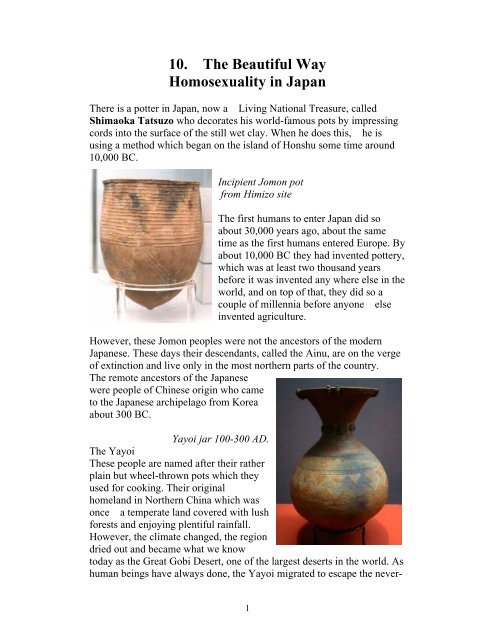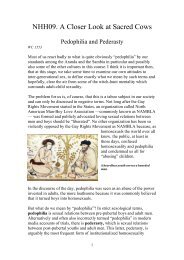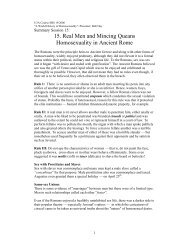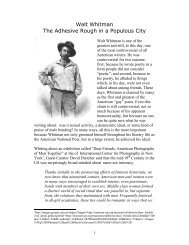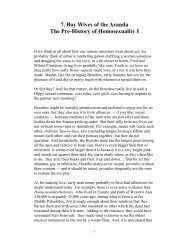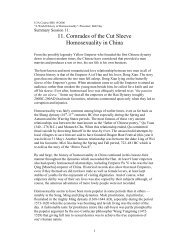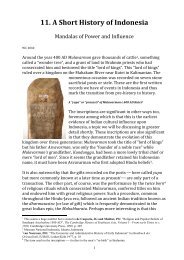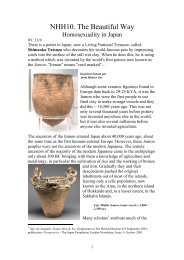10. The Beautiful Way Homosexuality in Japan
10. The Beautiful Way Homosexuality in Japan
10. The Beautiful Way Homosexuality in Japan
You also want an ePaper? Increase the reach of your titles
YUMPU automatically turns print PDFs into web optimized ePapers that Google loves.
<strong>10.</strong> <strong>The</strong> <strong>Beautiful</strong> <strong>Way</strong><br />
<strong>Homosexuality</strong> <strong>in</strong> <strong>Japan</strong><br />
<strong>The</strong>re is a potter <strong>in</strong> <strong>Japan</strong>, now a Liv<strong>in</strong>g National Treasure, called<br />
Shimaoka Tatsuzo who decorates his world-famous pots by impress<strong>in</strong>g<br />
cords <strong>in</strong>to the surface of the still wet clay. When he does this, he is<br />
us<strong>in</strong>g a method which began on the island of Honshu some time around<br />
10,000 BC.<br />
Incipient Jomon pot<br />
from Himizo site<br />
<strong>The</strong> first humans to enter <strong>Japan</strong> did so<br />
about 30,000 years ago, about the same<br />
time as the first humans entered Europe. By<br />
about 10,000 BC they had <strong>in</strong>vented pottery,<br />
which was at least two thousand years<br />
before it was <strong>in</strong>vented any where else <strong>in</strong> the<br />
world, and on top of that, they did so a<br />
couple of millennia before anyone else<br />
<strong>in</strong>vented agriculture.<br />
However, these Jomon peoples were not the ancestors of the modern<br />
<strong>Japan</strong>ese. <strong>The</strong>se days their descendants, called the A<strong>in</strong>u, are on the verge<br />
of ext<strong>in</strong>ction and live only <strong>in</strong> the most northern parts of the country.<br />
<strong>The</strong> remote ancestors of the <strong>Japan</strong>ese<br />
were people of Ch<strong>in</strong>ese orig<strong>in</strong> who came<br />
to the <strong>Japan</strong>ese archipelago from Korea<br />
about 300 BC.<br />
Yayoi jar 100-300 AD.<br />
<strong>The</strong> Yayoi<br />
<strong>The</strong>se people are named after their rather<br />
pla<strong>in</strong> but wheel-thrown pots which they<br />
used for cook<strong>in</strong>g. <strong>The</strong>ir orig<strong>in</strong>al<br />
homeland <strong>in</strong> Northern Ch<strong>in</strong>a which was<br />
once a temperate land covered with lush<br />
forests and enjoy<strong>in</strong>g plentiful ra<strong>in</strong>fall.<br />
However, the climate changed, the region<br />
dried out and became what we know<br />
today as the Great Gobi Desert, one of the largest deserts <strong>in</strong> the world. As<br />
human be<strong>in</strong>gs have always done, the Yayoi migrated to escape the never-<br />
1
end<strong>in</strong>g drought, settl<strong>in</strong>g for a time <strong>in</strong> the Korean Pen<strong>in</strong>sula only to be<br />
pushed out when a new wave of immigrants com<strong>in</strong>g beh<strong>in</strong>d them drove<br />
them onto the west coast of Honshu.<br />
<strong>The</strong> Yayoi brought with them a knowledge of agriculture and metallurgy,<br />
<strong>in</strong> particular the cultivation of rice and the work<strong>in</strong>g of bronze and iron.<br />
<strong>The</strong>y also brought with them a new religion which is usually called<br />
“Sh<strong>in</strong>to”. In this religion, almost everyth<strong>in</strong>g that was wondrous had a<br />
spirit, a “kami”: people, natural events and places, even the dead had<br />
their own “kami”. <strong>The</strong>se beliefs are what anthropologists call<br />
“animism”, a term taken from the Lat<strong>in</strong> “anima” mean<strong>in</strong>g the breath or<br />
soul. 1<br />
<strong>The</strong> First State<br />
Around about 300AD, a new émigré<br />
culture from Korea appeared on the<br />
Yamato pen<strong>in</strong>sula <strong>in</strong> the south-western<br />
part of the island of Honshu, around<br />
present-day Nara and Osaka. This culture<br />
is known as the Kofun after the tomb<br />
mounds they built. Like the Yayoi, the<br />
Kofun were divided <strong>in</strong>to clans which<br />
eventually were associated with each<br />
other <strong>in</strong> a k<strong>in</strong>d of loose political “state”.<br />
This Yamato state was ruled over by a<br />
k<strong>in</strong>g who exercised power over<br />
surround<strong>in</strong>g lords who, <strong>in</strong> turn owed their<br />
titles and possessions to their read<strong>in</strong>ess to<br />
go to war, a form of clan-based military<br />
aristocracy which became fundamental to the social and political<br />
structure of <strong>Japan</strong> until the Meiji Restoration <strong>in</strong> 1868.<br />
Most significantly for our story, it was dur<strong>in</strong>g this Kofun period that<br />
Confucian and Buddhist teachers first arrived <strong>in</strong> <strong>Japan</strong> (<strong>in</strong> 513 and<br />
522 AD respectively), mostly aga<strong>in</strong> from Korea, and with them, the art<br />
of writ<strong>in</strong>g. So, although there was a form of political unity <strong>in</strong> <strong>Japan</strong> from<br />
the 4 th century onwards, historical records don’t exist until the 7 th century.<br />
1 <strong>The</strong> concept was first <strong>in</strong>troduced by British anthropologist Sir Edward Burnett Tylor<br />
<strong>in</strong> his book "Primitive Culture" (published <strong>in</strong> 1871). the term was widely criticized <strong>in</strong><br />
the N<strong>in</strong>eteenth Century but has s<strong>in</strong>ce ga<strong>in</strong>ed general acceptance. Animism is believed<br />
to be the oldest form of religion, com<strong>in</strong>g to us from at least the Paleolithic and<br />
possibly well beyond.<br />
2
Significantly, although the Yamato court adopted Ch<strong>in</strong>ese writ<strong>in</strong>g, the<br />
Ch<strong>in</strong>ese calendar and a Ch<strong>in</strong>ese form of government, a Constitution<br />
was imposed by Pr<strong>in</strong>ce Shotoku <strong>in</strong> 604 AD which effectively made<br />
Buddhism the state religion. <strong>Japan</strong> thus became a nation with three<br />
religions, Confucian, Buddhism and their ancestral Sh<strong>in</strong>to.<br />
It was <strong>in</strong> the Buddhist monasteries dur<strong>in</strong>g the latter part of the Classical<br />
age, the Heian period, 794-1192 AD that a form of <strong>in</strong>stitutionalised<br />
homosexuality emerged. This was known as nanshoku.<br />
Nanshoku and the Buddhist monks:<br />
<strong>The</strong> moral position of homosexuality<br />
<strong>in</strong> old <strong>Japan</strong> was well summed up <strong>in</strong><br />
what appears to be a term paper for an<br />
English class written by an<br />
anonymous <strong>Japan</strong>ese student: 2<br />
It would be important to note that<br />
religion is where most concerns about<br />
sexuality stem from, and where much<br />
hostility towards homosexuality<br />
orig<strong>in</strong>ates. Sh<strong>in</strong>to and<br />
Buddhism……… do not regard<br />
homosexuality as a s<strong>in</strong>. Sh<strong>in</strong>to is a<br />
creed that teaches harmony, sanctity<br />
of human life and nature and respect<br />
for people and their <strong>in</strong>dividuality. It<br />
has no developed theology or sacred scriptures, and thus there are<br />
no clear-cut tenets on sexuality………… <strong>The</strong>y do not consider<br />
wrongdo<strong>in</strong>gs as “s<strong>in</strong>”, but as actions which dirty one’s purity, to<br />
be cleansed to preserve one’s <strong>in</strong>ner peace. As far as Sh<strong>in</strong>to was<br />
concerned, homosexual activity was acceptable as long as it did<br />
not disrupt the community, an aspect of human liv<strong>in</strong>g which the<br />
religion also places <strong>in</strong> high regard.<br />
Mahayana Buddhism <strong>in</strong> the <strong>Japan</strong>ese context also does not classify<br />
deeds as “good” or “evil” by themselves, but by their <strong>in</strong>tention<br />
and outcome. This <strong>Japan</strong>ese understand<strong>in</strong>g of Buddhism<br />
considered an <strong>in</strong>tention as either “skillful” or “unskillful” <strong>in</strong><br />
lessen<strong>in</strong>g attachment to our world of suffer<strong>in</strong>g, which we are born<br />
2 http://www.tabulas.com/~syzygy/content/18124.html<br />
3
<strong>in</strong>to…… Buddhism did not concern itself with procreation, as it<br />
re<strong>in</strong>forced the cycle of rebirths; however, <strong>in</strong> Mahayana Buddhism,<br />
sex was used as a religious symbol and <strong>Japan</strong>ese Buddhism<br />
separated sex from procreation, see<strong>in</strong>g sex as a good <strong>in</strong> itself.<br />
One of the most important figures to emerge <strong>in</strong> <strong>Japan</strong>ese history — at<br />
least from our po<strong>in</strong>t of view — was a Buddhist monk called Kukai (774-<br />
835) who studied for a long time at monstries <strong>in</strong> T’ang Dynasty Ch<strong>in</strong>a<br />
and from there, brought back to <strong>Japan</strong> a form of Buddhism called “True<br />
Words” or, <strong>in</strong> <strong>Japan</strong>ese, Sh<strong>in</strong>gon. This became the most <strong>in</strong>fluential form<br />
of Buddhism <strong>in</strong> <strong>Japan</strong>ese culture. In expla<strong>in</strong><strong>in</strong>g this, Richard Hooker 3<br />
wrote:<br />
Kukai believed that the True Words transcended speech, so he<br />
encouraged the cultivation of artistic skills: pa<strong>in</strong>t<strong>in</strong>g, music, and<br />
gesture. Anyth<strong>in</strong>g that had beauty revealed the truth of the Buddha;<br />
as a result, the art of the Hiei monks made the religion profoundly<br />
popular at the Heian court and deeply <strong>in</strong>fluenced the development<br />
of <strong>Japan</strong>ese culture that was be<strong>in</strong>g forged at that court. It is not<br />
unfair to say that <strong>Japan</strong>ese poetic and visual art beg<strong>in</strong> with the<br />
Buddhist monks of Mount Hiei and Mount Koya.<br />
Statue of Kukai<br />
It is commonly believed that it was Kukai himself who <strong>in</strong>troduced a form<br />
of homosexual activity which became <strong>in</strong>stitutionalised with<strong>in</strong> the Mt<br />
Koya monastery he founded on his return from Ch<strong>in</strong>a. This was called<br />
nanshoku which literally means “male colours” but is generally used to<br />
3 Richard Hooker: on “World Civilisations – an Internet Classroom and Anthology”,<br />
Wash<strong>in</strong>gton State University at<br />
http://www.wsu.edu:8080/~dee/ANCJAPAN/YAYOI.HTM<br />
4
mean male-male love and specifically refers to the practice of monks<br />
form<strong>in</strong>g sexual alliances with their younger acolytes or chigo. 4 Whether<br />
it was true or not that Kukai himself was responsible is open to question:<br />
he himself never discussed it <strong>in</strong> any of his writ<strong>in</strong>gs and he seems to have<br />
been an advocate for the V<strong>in</strong>aya code whereby monks were forbidden any<br />
form of sexual activity.<br />
Even so, the monastery at Mt Koya became a by-word for same-sex love,<br />
the monks rationalis<strong>in</strong>g their affairs with younger chigo on the grounds<br />
that the vow of chastity applied only to sex with women and not to sex<br />
with males because it was not procreative. A whole literature evolved of<br />
stories about love relations among monks and their young acolytes<br />
known as Chigo Monogatari. Although these began <strong>in</strong> the N<strong>in</strong>th<br />
century, the practice of nanshoku persisted, becom<strong>in</strong>g more idealised as<br />
time went by. So, for example, when the first Portuguese traders made<br />
contact with <strong>Japan</strong> <strong>in</strong> the 15 th Century, the Jesuit priests who<br />
accompanied them reported home <strong>in</strong> horror that sodomy was plentiful<br />
<strong>in</strong> the Buddhist monasteries.<br />
Although tell<strong>in</strong>g tales from the monasteries was popular, there were other<br />
references to homosexual relationships dur<strong>in</strong>g the Heian period. Apart<br />
from some obscure diary entries, the earliest and best known references<br />
are <strong>in</strong> the 11 th century Genji Monogatari or <strong>The</strong> Tale of Genji. In<br />
this men are often attracted by the beauty of youths and <strong>in</strong> one scene,<br />
when the hero is rejected by a lady, he turns <strong>in</strong>stead to her brother:<br />
Genji pulled the boy down beside him . . Genji, for his part, or so<br />
one is <strong>in</strong>formed, found the boy more attractive than his chilly<br />
sister.<br />
This is not the place to try and tell the story of <strong>The</strong> Tale of Genji. It is a<br />
huge book, arguably written by several authors, written <strong>in</strong> a difficult<br />
form of Old <strong>Japan</strong>ese and the characters are not named but referred to<br />
either by their social rank <strong>in</strong> the case of males, or the colour of their<br />
clothes <strong>in</strong> the case of women.<br />
<strong>The</strong> Love of Warriors — <strong>The</strong> <strong>Beautiful</strong> <strong>Way</strong><br />
In the early days of battles between uji or clans, the war chiefs led the<br />
men of the clan <strong>in</strong>to war, much as we might understand battles between<br />
the Scots clans. In the early “Classical” era, dur<strong>in</strong>g the Nara period<br />
(710-794 AD), a system of local militias of mounted horsemen was<br />
4 Gary Leupp: Male Colors: <strong>The</strong> Construction of <strong>Homosexuality</strong> <strong>in</strong> Tokugawa <strong>Japan</strong>,<br />
Berkeley: University of California Press, 1995.<br />
5
established. Although orig<strong>in</strong>ally these men were the servants or samurai<br />
of the Emperor, gradually the militias evolved <strong>in</strong>to private armies ow<strong>in</strong>g<br />
loyalty to the great aristocratic families.<br />
<strong>The</strong>se early samurai were not the noble and cultured professional soldiers<br />
who followed the code later called bushido or “the way of the warrior”<br />
but men drawn from the lower classes who spent most of their time<br />
earn<strong>in</strong>g a liv<strong>in</strong>g as farmers and became soldiers only when their lords<br />
called upon them to fight oppos<strong>in</strong>g armies. <strong>The</strong> samuari who lived<br />
accord<strong>in</strong>g to the bushido did not emerge until the Tokugawa shogunate<br />
which began <strong>in</strong> the 17 th Century. By then the Samurai had become a class<br />
of highly tra<strong>in</strong>ed, discipl<strong>in</strong>ed professional soldiers who hired themselves<br />
out to clan chiefs and great houses dur<strong>in</strong>g the middle ages <strong>in</strong> <strong>Japan</strong>.<br />
It was among these later, far more sophisticated and socially elevated<br />
samurai that the most famous <strong>Japan</strong>ese homosexual <strong>in</strong>stitution was to<br />
emerge.<br />
If, like me, you are a fan of the movies made by the <strong>Japan</strong>ese director,<br />
Akira Kurosawa, you will be familiar with the ways of the Samurai but<br />
<strong>in</strong> none of Kurosawa’s movies will you see even a h<strong>in</strong>t of one of their<br />
great driv<strong>in</strong>g <strong>in</strong>stitutions, the wakashudo (the way of youth) or bi-do (the<br />
beautiful way).<br />
Writ<strong>in</strong>g <strong>in</strong> the 2004 Androphile Project 5 , an unsigned author commented:<br />
From its pivotal position <strong>in</strong> the education, code of honor, and<br />
erotic life of the samurai class, the love of youths has sunk below<br />
the level of the untouchable to the level of the unmentionable, truly<br />
“the love that dare not speak its name”. But the <strong>in</strong>delible fact<br />
rema<strong>in</strong>s that one of the fundamental aspects of samurai life was the<br />
emotional and sexual bond cultivated between an older warrior<br />
and a younger apprentice, a love for which the <strong>Japan</strong>ese have<br />
many names, as many perhaps as the Eskimo have for snow.<br />
With the advantage of be<strong>in</strong>g <strong>in</strong> the right place at the right time, another<br />
writer, Ijiri Chusuke 6 , argued <strong>in</strong> 1482 that:<br />
“In our empire of <strong>Japan</strong> this way flourished from the time of the<br />
great master Kobo. In the abbeys of Kyoto and Kamakura, and <strong>in</strong><br />
5 Androphile Project 2004,<br />
http://www.androphile.org/preview/Culture/<strong>Japan</strong>/japan.htm<br />
6 Ijiri Chusuke, 1482 "<strong>The</strong> Essence of Jakudo" <strong>in</strong> <strong>The</strong> Love of the Samurai, A<br />
Thousand Years of <strong>Japan</strong>ese <strong>Homosexuality</strong> by Tsuneo Watanabe and Jun’ichi Iwata,<br />
1989, London, <strong>The</strong> Gay Men’s Press, p. 109.<br />
6
the world of the nobles and the warriors, lovers would swear<br />
perfect and eternal love rely<strong>in</strong>g on no more than their mutual good<br />
will. Whether their partners were noble or common, rich or poor,<br />
was absolutely of no importance… In all these case they were<br />
greatly moved by the spirit of this way. This way must be truly<br />
respected, and it must never be permitted to disappear.”<br />
Fortunately, we can get a glimpse of the “beautiful way” at the movies<br />
with the 1999 film, released <strong>in</strong> Australia under the title of “Taboo” but<br />
orig<strong>in</strong>ally called “Gohatto”, directed by Nagisa Oshima (Merry<br />
Christmas Mr Lawrence, In the Realm of the Senses, etc). In this<br />
sensual and dream-like movie set <strong>in</strong> 1865, three years before the fall of<br />
the Tokugawa shogunate, we see the havoc a very beautiful if flirtatious<br />
youth creates when he jo<strong>in</strong>s a group of samurai, several of whom then<br />
compete with each other for his favours.<br />
<strong>The</strong> same anonymous Androphile author also writes:<br />
Known also as wakashudo, “the way of the youth”, it was a<br />
practice engaged <strong>in</strong> by all members of the samurai class, from<br />
lowliest warrior to highest lord. Indeed it has been said that it<br />
would never have been asked of a daimyo, ( or lord), why he took<br />
boys as lovers, but why he didn’t. This last is not a question that<br />
would have troubled, for example, the three great shoguns who<br />
unified <strong>Japan</strong>, Oda Nobunaga, Toyotomi Hideyoshi, or Tokugawa<br />
Ieyasu, nor for that matter Miyamoto Musashi, the author of “<strong>The</strong><br />
Book of Five R<strong>in</strong>gs.” 7<br />
Although <strong>in</strong> many ways like pederasty <strong>in</strong> Ancient Greece, wakashudo —<br />
usually abbreviated to shudo —differed <strong>in</strong> one major respect <strong>in</strong> that <strong>in</strong><br />
<strong>Japan</strong> it was the adolescent youth who sought out and wooed the older<br />
man, and not the other way around as <strong>in</strong> Greece. However, as <strong>in</strong> Greece,<br />
the sexual part of the relationship customarily ended when the youth<br />
reached manhood, usually around age 19 or so. Of course that did not<br />
mean the men ceased to know each other: most commonly a close<br />
friendship lasted for the rest of their lives and, <strong>in</strong> some cases, the men<br />
cont<strong>in</strong>ued the erotic relationship long past the conventional time. As <strong>in</strong><br />
Greece, this shudo relationship did not rule out marriage because most<br />
7 Gary P. Leupp, 1995, Male Colors, the Construction of <strong>Homosexuality</strong> <strong>in</strong> Tokugawa<br />
<strong>Japan</strong>, Berkely, <strong>The</strong> University of California Press, p. 53. <strong>The</strong> “Book of 5 R<strong>in</strong>gs”,<br />
accord<strong>in</strong>g to Wikipedia, is “an enigmatic book of strategy, tactics, and philosophy<br />
used as the personal mantras for bus<strong>in</strong>esspeople and martial artists alike” written by<br />
Miyamoto Musashi who is regarded as the greatest swordsman ever <strong>in</strong> <strong>Japan</strong>..<br />
7
Samurai married but generally, later <strong>in</strong> life than was common among<br />
other classes.<br />
As <strong>in</strong> Greece and as we have seen <strong>in</strong> other parts of the world also, it was<br />
firmly believed that the relationship between man and youth was<br />
essentially a way of transmitt<strong>in</strong>g the manly virtues from one generation to<br />
the other and that this was done, not only by the older man serv<strong>in</strong>g as a<br />
good role model, but also through sexual <strong>in</strong>tercourse of one form or<br />
another. Just as the monks on Mount Koya argued that sex<br />
was itself a means of explor<strong>in</strong>g the spiritual world, so too the physical<br />
relationship between man and youth took on a spiritual mean<strong>in</strong>g <strong>in</strong> the<br />
shudo. In 1653, <strong>in</strong> a book called , “A Dog’s Idle Hours” (Inu Tsurezure)<br />
an anonymous author wrote:<br />
“It is natural for a samurai to make every effort to excel with pen<br />
and sword. Beyond that, what is important to us is not ever to<br />
forget, even to our last moment, the spirit of shudo. If we should<br />
forget it, it will not be possible for us to ma<strong>in</strong>ta<strong>in</strong> the decencies,<br />
nor gentleness of speech, nor the ref<strong>in</strong>ements of polite behavior.” 8<br />
Honoured and <strong>in</strong>deed, revered as it was, shudo was not to be entered <strong>in</strong>to<br />
lightly. A boy was admonished to seek out and observe a man for at least<br />
five years before he approached him and requested the apprentice-like<br />
Male couple on a futon: Early 1680's; One of the very first examples of handcolored<br />
ukiyo-e pr<strong>in</strong>ts <strong>in</strong> the shunga (erotic) style. Moronobu Hishikawa (1618-<br />
1694); Ôban format, <strong>10.</strong>25" x 15"; Sumi <strong>in</strong>k and color on paper; Private collection.<br />
8 William Scott Wilson, trans. 1979. Yamamoto Tsunetomo, Hagakure, <strong>The</strong> Book of<br />
the Samurai New York and Tokyo, Kodansha International, p. 58.<br />
8
elationship. This meant that boys, some time before they were of an<br />
age to enter shudo, would have had to be consider<strong>in</strong>g the available adult<br />
men because they generally underwent the com<strong>in</strong>g-of-age ceremony<br />
when they were about 18-19 years old. It was at this time that the youth<br />
received the tonsure <strong>in</strong> which his hair was shaved back from his forehead<br />
to emulate a reced<strong>in</strong>g hairl<strong>in</strong>e and thus appear older (<strong>in</strong> <strong>Japan</strong>, age<br />
matters – people compare birthdays <strong>in</strong> order to know who should bow a<br />
little lower to the other).<br />
Although shudo among the Samurai owed much to the nanshoku of the<br />
Buddhist monks of the Heian era, it reached its peak dur<strong>in</strong>g the<br />
Tokugawa shogunate which began <strong>in</strong> 1603 9 but from that time on, the<br />
practice gradually decl<strong>in</strong>ed as the country became <strong>in</strong>creas<strong>in</strong>gly unified<br />
and the need for a warrior class dim<strong>in</strong>ished.<br />
<strong>Homosexuality</strong> among the Middle-Classes<br />
<strong>The</strong> long period of peace dur<strong>in</strong>g the Tokugawa shogunate saw the rise of<br />
a middle class along with the growth of trade. For a time, they even<br />
traded with Europe, the <strong>Japan</strong>ese want<strong>in</strong>g firearms and shipbuild<strong>in</strong>g<br />
skills, the Europeans after silks and ceramics. 10 <strong>Japan</strong> orig<strong>in</strong>ally opened<br />
its doors, first to the Portuguese <strong>in</strong> 1542 and later, to the Dutch, but it<br />
slammed them shut aga<strong>in</strong> and conf<strong>in</strong>ed the Dutch to the one small trad<strong>in</strong>g<br />
entrepot at Nagasaki, pr<strong>in</strong>cipally because they disliked the activities of<br />
Jesuit and Franciscan missionaries and their <strong>in</strong>tolerant attitudes to<br />
Sh<strong>in</strong>to and Buddhism.<br />
Dur<strong>in</strong>g this period, the traditions of both shudo and nanshoku <strong>in</strong>filtrated<br />
the high society which became known as the “Float<strong>in</strong>g World”, the life <strong>in</strong><br />
the pleasure quarters of the cities, but especially Edo from about the<br />
17 th until t the end of the 19 th centuries. This was the world depicted <strong>in</strong><br />
many of the famous <strong>Japan</strong>ese wood-block pr<strong>in</strong>ts, the ukiyo-e. While we<br />
th<strong>in</strong>k of this as the time of geisha and the tea-ceremony, it is also the<br />
time when the kobuki and no theatres were at their peak of popularity.<br />
Orig<strong>in</strong>ally, women had performed <strong>in</strong> the theatres but eventually were<br />
banned because it was thought they would corrupt public morals. From<br />
then on, boys dressed and made up to look like women, played the female<br />
roles <strong>in</strong> much the same way that boy actors portrayed Shakespeare’s<br />
9 which <strong>in</strong>cidentally, was the year Elizabeth I died and James VI of Scotland<br />
succeeded her as James I.<br />
10 A good read on the subject is Giles Milton: “Samurai William, <strong>The</strong> Adventurer<br />
Who Unlocked <strong>Japan</strong>”, Hodder & Stoughton, London 2002.<br />
9
hero<strong>in</strong>es. Strange as it might seem to us, young male faces made up <strong>in</strong> the<br />
female manner were considered the ideal of female beauty!<br />
Kabuki actors known as kagema, became the media stars of their day,<br />
able to charge fortunes for their sexual favours from the wealthy patrons<br />
who pursued them. This form of male prostitution gave rise to countless<br />
literary and artistic works with many of the greatest artists of the time<br />
document<strong>in</strong>g both the kagema and their activities. Although some of the<br />
better-known artists used false names to protect their reputation, few<br />
could avoid produc<strong>in</strong>g ukiyo-e (“pictures of the float<strong>in</strong>g world”) or,<br />
where their pictures were more erotic, what were known as shunga<br />
(“pictures of spr<strong>in</strong>g”). Great artists whose names are house-hold words<br />
among Western collectors, such as Hokusai and Hiroshige, produced<br />
works of this k<strong>in</strong>d.<br />
Spr<strong>in</strong>g Pastimes — A tryst between an older man and a youth — by<br />
Miyagawa Isshô, ca. 1750. This is a Shunga hand-scroll (sumi, color and<br />
gofun on silk) a dalliance between an older man and a young kabuki actor<br />
(known as onnagata or kagema) who often doubled as rent-boys and were<br />
much sought after by the “stage door johnnies” of their day.<br />
<strong>The</strong> Tokugawa shogunate also saw the emergence of a male cult known<br />
as onnagirai. <strong>The</strong>se were the “women haters”, men who were<br />
exclusively homosexual <strong>in</strong> their behaviour. This stands out aga<strong>in</strong>st the<br />
bisexuality which had always been traditional <strong>in</strong> <strong>Japan</strong>ese culture. Of<br />
10
course there had long been an attitude that women were “unclean” and<br />
that sex with women “polluted” a man’s spirit, the pollution hav<strong>in</strong>g to be<br />
lifted by appropriate religious rituals. To some degree, this was the basis<br />
for both nanshoku among the monks and shudo among the samurai, but<br />
it had not before become an <strong>in</strong>stitutionalized form of exclusive<br />
homosexuality. Doubtless, onnagirai also took strength from the<br />
seclusion of the monks and from the <strong>in</strong>creas<strong>in</strong>g seclusion of the samurai<br />
when peace meant they had little work to do and were mostly conf<strong>in</strong>ed to<br />
all-male barracks <strong>in</strong> the castles or with<strong>in</strong> the cities.<br />
<strong>The</strong> end of shudo and the float<strong>in</strong>g world<br />
In 1868 the decrepit Tokugawa shogunate was ended by the Meiji<br />
Restoration and <strong>Japan</strong> was prised open for bus<strong>in</strong>ess with the West by<br />
American gun-ships. This of course is the time of Madama Butterfly!<br />
Increas<strong>in</strong>gly conscious of the outside world’s view of them, the <strong>Japan</strong>ese<br />
began to hide and eventually abolish the old sexual traditions which had<br />
become embarrass<strong>in</strong>g <strong>in</strong> the world of <strong>in</strong>ternational relations. In<br />
comparison, the Meiji period was rather wowserish and “Victorian” <strong>in</strong><br />
our terms, so much so that WS Gilbert <strong>in</strong> “<strong>The</strong> Mikado” sent it up by<br />
mak<strong>in</strong>g behead<strong>in</strong>g the punishment for flirt<strong>in</strong>g!<br />
<strong>Homosexuality</strong> <strong>in</strong> modern <strong>Japan</strong><br />
<strong>The</strong>re are no laws aga<strong>in</strong>st homosexual behaviour <strong>in</strong> modern <strong>Japan</strong>.<br />
However, the old acceptance has gone, banished by the <strong>in</strong>creas<strong>in</strong>g<br />
<strong>in</strong>fluence of Western values on the matter. Through the various wars of<br />
the 20 th Century, the militaristic values of the bushido, the samurai cult,<br />
rega<strong>in</strong>ed some of their old vigour but generally speak<strong>in</strong>g, the attitude was<br />
that homosexuality was best kept hidden from public gaze. <strong>The</strong><br />
American occupation follow<strong>in</strong>g the Second World War perhaps more<br />
than any other s<strong>in</strong>gle <strong>in</strong>fluence <strong>in</strong>troduced notions of crim<strong>in</strong>ality and<br />
illness, marg<strong>in</strong>ality and perversion which the <strong>Japan</strong>ese had not associated<br />
with homosexual behaviour <strong>in</strong> the past.<br />
Another big factor was the large numbers of young <strong>Japan</strong>ese who went<br />
abroad to study as part of their government’s drive to modernize the<br />
country from a mostly agrarian to an <strong>in</strong>dustrialized nation.<br />
However, of course homosexual behaviour still went on even if it was<br />
now someth<strong>in</strong>g to be kept private and considered by the society at large<br />
to be rather shameful. “Gay” <strong>in</strong> our sense of the word is not really<br />
applicable to contemporary <strong>Japan</strong>ese homosexuals even though there is a<br />
11
homophile movement <strong>in</strong> the country. This, as Mark McLelland 11 from<br />
Murdoch University suggests, is because the American (and more or less<br />
the Australian) gay identity is not one which sits comfortably on the<br />
<strong>Japan</strong>ese. But, that caveat aside, McLelland stresses that:<br />
…… representations of (primarily male) homosexual love and even<br />
sex permeate <strong>Japan</strong>ese popular culture to an extent that would be<br />
unimag<strong>in</strong>able <strong>in</strong> the US or Europe and that 'homosexuality' <strong>in</strong><br />
<strong>Japan</strong> is therefore very differently conceptualised.<br />
However, I must po<strong>in</strong>t out that the visibility of 'homosexuality' <strong>in</strong><br />
<strong>Japan</strong>ese media such as comic books, women's magaz<strong>in</strong>es, TV<br />
dramas and talk-shows, movies and popular fiction has not created<br />
the space for <strong>in</strong>dividuals express<strong>in</strong>g lesbian or gay 'identities' to<br />
come out <strong>in</strong> actual life. Yet, as recent research has shown 12 , the<br />
notion of 'com<strong>in</strong>g out' is seen as undesirable by many <strong>Japan</strong>ese gay<br />
men and lesbians as it necessarily <strong>in</strong>volves adopt<strong>in</strong>g a<br />
confrontational stance aga<strong>in</strong>st ma<strong>in</strong>stream lifestyles and values,<br />
which many still wish to endorse.<br />
McLelland (from whom I am tak<strong>in</strong>g most of this) does po<strong>in</strong>t out that the<br />
famous <strong>Japan</strong>ese novelist, Mishima Yukio who espoused the code of<br />
the samurai and was also famously homosexual, co<strong>in</strong>ed the term<br />
danshoku-ka to mean much the same as “homosexualist” and also used<br />
the word “gay” <strong>in</strong> his work, but this last was a foreign borrow<strong>in</strong>g more<br />
specifically referr<strong>in</strong>g to cross-dress<strong>in</strong>g male prostitutes.<br />
It is difficult to assess exactly what is meant by “homosexuality” <strong>in</strong><br />
<strong>Japan</strong> because the media seem to conflate same-sex desire with crossdress<strong>in</strong>g<br />
and trans-genderism and at times to portray it as a k<strong>in</strong>d of<br />
“hobby” or a form of “play”. This rather confused and trivializ<strong>in</strong>g<br />
attitude can be best seen <strong>in</strong> two major <strong>in</strong>stitutions of <strong>Japan</strong>ese<br />
contemporary life: <strong>in</strong> the comic books called manga and their animated<br />
form, called anime.<br />
Anime and Manga<br />
Many manga and anime conta<strong>in</strong> male homosexual stories and bedroom<br />
scenes. S<strong>in</strong>ce the 1970s, a genre of manga and anime has developed<br />
11 Mark McLelland: <strong>Homosexuality</strong> and Popular Culture <strong>in</strong> Modern <strong>Japan</strong>,<br />
http://wwwsshe.murdoch.edu.au/<strong>in</strong>tersections/issue3/mclelland2.html<br />
12 McLelland refers to his own Male <strong>Homosexuality</strong> <strong>in</strong> Modern <strong>Japan</strong>: Cultural<br />
Myths and Social Realities, Richmond: Curzon Press – then <strong>in</strong> press; and to Wim<br />
Luns<strong>in</strong>g, Beyond Common Sense, 1999a.<br />
12
especially for women fasc<strong>in</strong>ated by the “boy-love” theme, a genre<br />
<strong>in</strong>creas<strong>in</strong>gly written and drawn by women themselves.<br />
However, I would describe the romantic and sexual relationships<br />
<strong>in</strong> these stories as 'homosexual' deploy<strong>in</strong>g the <strong>in</strong>verted commas to<br />
show that what is be<strong>in</strong>g described here is a very specific<br />
construction or, better, 'fantasy' of what male homosexual love<br />
means. Not only are the male characters not supposed to represent<br />
'gay men,' they do not really represent 'men' either, <strong>in</strong> that they are<br />
referred to as bishoonen or 'beautiful boys/youths.' <strong>The</strong>y are drawn<br />
<strong>in</strong> such a way as to suggest an androgynous ideal: they have tall,<br />
slender bodies, high cheek bones and po<strong>in</strong>ted ch<strong>in</strong>s, wide eyes and<br />
long flow<strong>in</strong>g hair. Also, they behave <strong>in</strong> a rather 'fem<strong>in</strong><strong>in</strong>e' manner,<br />
express<strong>in</strong>g the emotionality and vulnerability often associated with<br />
female characters <strong>in</strong> more ma<strong>in</strong>stream fiction.<br />
Various commentators have, then, argued that the bishoonen are<br />
not really 'men' but fantastic, androgynous creatures created by<br />
<strong>Japan</strong>ese women as an expression of dissatisfaction with current<br />
gender stereotypes and the 'narrow life paths' which restrict<br />
women <strong>in</strong> the real world. 13<br />
Despite the plethora of images of homosexual men <strong>in</strong> the women’s<br />
media, men themselves seem to be relatively unaffected by them. Many<br />
regard these as figments of women’s imag<strong>in</strong>ation, ideals of beauty which<br />
would be unatta<strong>in</strong>able <strong>in</strong> real life.<br />
However, there is evidence that these notions are more than just daydreams<br />
for many women. As McLelland reports,<br />
Start<strong>in</strong>g with a series of articles <strong>in</strong> the women's magaz<strong>in</strong>e CREA <strong>in</strong><br />
February 1991, entitled 'Gay Renaissance,' <strong>Japan</strong>ese women's<br />
media began to <strong>in</strong>terest themselves <strong>in</strong> <strong>Japan</strong>'s gay subculture<br />
which resulted <strong>in</strong> what has s<strong>in</strong>ce been termed <strong>Japan</strong>'s 'gay<br />
boom’…. One article <strong>in</strong> CREA under the headl<strong>in</strong>e of 'Women who<br />
plan on spend<strong>in</strong>g a pleasurable life with gays' expla<strong>in</strong>s that<br />
women's <strong>in</strong>terest <strong>in</strong> develop<strong>in</strong>g not just friendships with gay men,<br />
but cohabit<strong>in</strong>g relationships, results from the negative image they<br />
have of traditional mascul<strong>in</strong>ity and mascul<strong>in</strong>e roles. In this article,<br />
and others like it, it is assumed that gay men are radically different<br />
from their straight counterparts and can even be 'best partners'<br />
[besuto paatonaa] for women. Ma<strong>in</strong>stream magaz<strong>in</strong>es such as the<br />
tabloid-style SPA (18 March 1998) have also picked up on this<br />
13 McLelland, ibid.<br />
13
trend and begun to run articles on the 'boom' <strong>in</strong> 'friendship<br />
marriages' [yuujoo kekkon) which are supposed to be <strong>in</strong>creas<strong>in</strong>g<br />
between straight women and 'gays' [gei]. <strong>The</strong> women <strong>in</strong>terviewed<br />
<strong>in</strong> the SPA article, entitled 'Women who choose gays and gays<br />
who choose women,' mention a number of attractive features<br />
supposedly possessed by gay men which their straight counterparts<br />
lack. <strong>The</strong>se <strong>in</strong>clude their will<strong>in</strong>gness to negotiate roles with<strong>in</strong> the<br />
marriage and to help with housework. <strong>The</strong> writer mentions that it<br />
is a cause for concern that straight men are assumed not to have<br />
these qualities, but the assumption that these qualities are<br />
characteristic of gay men goes unchallenged.<br />
<strong>The</strong> fantasy of the gay man as a woman's 'best partner' is most<br />
clearly developed <strong>in</strong> 'gay boom' movies directed at a female<br />
audience which focus on the relationships between straight women<br />
and gay men……[one of which is a movie called] Tw<strong>in</strong>kle. . In<br />
this movie, the couple agree to a 'camouflage marriage'<br />
[kamofuraaji kekkon] to escape the <strong>in</strong>tense pressure from family<br />
and colleagues to get married. After a series of emotional traumas<br />
aris<strong>in</strong>g when the husband is 'outed' to his <strong>in</strong>-laws, it becomes clear<br />
that they have actually fallen <strong>in</strong> love and they decide to cont<strong>in</strong>ue as<br />
a married couple, albeit mak<strong>in</strong>g space <strong>in</strong> their relationship to<br />
accommodate the husband's boyfriend. In both the above<br />
relationships gay men are shown to be offer<strong>in</strong>g women the k<strong>in</strong>d of<br />
love, appreciation and respect denied to them by straight men.<br />
However, there is no suggestion that the gay men have been<br />
converted to heterosexuality, for <strong>in</strong> these narratives it is<br />
heterosexual men and the sexist 'system' which produces them that<br />
is irretrievably 'other' to the female hero<strong>in</strong>es.<br />
14
“Boy-love” yaoi (Manga for women)<br />
<strong>Japan</strong>ese fem<strong>in</strong>ist writer, Ueno Chizuko 14 states that<br />
'neither men nor women are sleep<strong>in</strong>g with the opposite sex, they<br />
are sleep<strong>in</strong>g with a system' which always works to the<br />
disadvantage of women So women turn to images of sex between<br />
men which are, as one woman told Sarah Schulman 15 , ………..<br />
the only picture we have of men lov<strong>in</strong>g someone else as an equal. It<br />
is the k<strong>in</strong>d of love we want to have.'<br />
14 Ueno Chizuko, Sukaato no shita no gekiba [<strong>The</strong> theater under the skirt), Tokyo:<br />
Kawade Bunko, 1992, p. 140., quoted <strong>in</strong> McLelland, ibid.<br />
15 Sarah Schulman, My American History: Lesbian and Gay Life Dur<strong>in</strong>g the Reagan<br />
and Bush Years, London: Cassell, 1994, p. 245.<br />
15
Personally, I am <strong>in</strong>cl<strong>in</strong>ed to th<strong>in</strong>k that if this is really a trend <strong>in</strong> modern<br />
<strong>Japan</strong>ese society, that this gay man/straight woman marriage is not all<br />
that different from the arrangements of the past when men had both boylovers<br />
and wives at the same time.<br />
However, it also seems that the images modern women have of an equal<br />
relationship between two men most certa<strong>in</strong>ly did not apply <strong>in</strong> the past and<br />
must be a relatively new idea <strong>in</strong> <strong>Japan</strong>, that of age-peer relationships. In<br />
neither the “nanshoku” nor <strong>in</strong> the shudo relationships were the youths<br />
and grown men on an equal foot<strong>in</strong>g, the youth <strong>in</strong> both cases always be<strong>in</strong>g<br />
subord<strong>in</strong>ate to the older man. Indeed, probably the most important<br />
justifications for those <strong>in</strong>stitutions was that they were pedagogic<br />
relationships <strong>in</strong> which the youths started out socially <strong>in</strong>ferior, much like<br />
women, but who were helped to achieve full manly status and power<br />
through their relationships with their mentors. It is perhaps our own<br />
cultural values which cause us to focus almost exclusively on the sexual<br />
relationship between youth and his mentor, and not first and foremost on<br />
the much wider social functions that the relationship served.<br />
___________________________________________________________<br />
_________<br />
16


